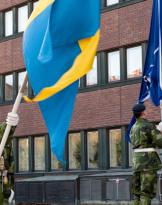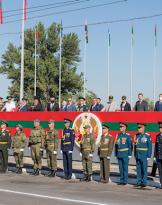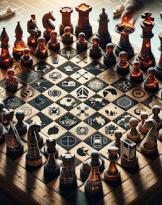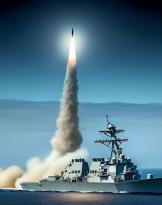Try to forget and change the story to your liking is a much loved mental exercise in Italy, so much so that you have come to dispute gadgets, the last but not the only case, depicting the means and the emblem of the Xa MAS flotilla, present in the shop of the Naval Museum of La Spezia. Obviously "an affront" of this kind is not acceptable in a city Silver Medal for Military Valor for the War of Liberation. Too bad that those who have accused of selling fascist material and dangerous for the democratic order, it is never that the cups depicting an SLC are used for subversive acts, probably has a short memory, since La Spezia was the seat of the Tenth during the war , as well as confused ideas. More simply it is in bad faith.
Better to try and forget who fought the war, much preferring death to becoming a prisoner of the British. Of the Brits? Yes because what perhaps does not remember the former mayor of La Spezia and that the Xa MAS flotilla, before dividing into two sections between those who remained loyal to Germany and who to the King, was an elite unit of the Royal Navy. The few, obviously excluded the submarines and in some occasions the surface fleet, which effectively fought the war, in an unconventional way going to operate directly inside the enemy ports.
Is not it worth it to remember with greater emphasis those Italians who fought for a cause, right or wrong, giving in return also life to try to change the balance in the Mediterranean? In a normal country it would be like that, but in Italy we prefer to remember something else. It is hard to admit that the Tenth has left a tangible legacy in all the special forces of the world, since even the Navy Seals have taken much of their training and their operating procedures from those hundred men who clashed against two fleets (the Mediterranean Fleet of Alexandria and the Force H of Gibraltar ed), citing the title of Admiral Virgilio Spigai. Right here is the problem, the cleverness, not even too much in fact, trying to close those symbols all in the tenth of Commander Borghese (photo), the one who fought in CSR without major operations at sea becoming almost an earthly force. But the real Tenth, which had the same symbol and the same uniforms, was that stationed in La Spezia from 1938 to 15 in March 1940 under the name of Ia MAS flotilla and that ended the war 8 September 1943 with the entry into force of the Armistice.
Do not the fallen in war deserve to be remembered as well as the fallen of the Resistance? Does not it deserve to be remembered a man of moral and military caliber as Licio Visintini (a name for everyone, ed)? Or the genius of the Borghese commander before the Scirè then the Underwater Department of the Tenth and, finally, the department itself? Probably not, they deserve to be punished for eternal memory of having fought a war, meaning that from 1940 to 1943, giving everything possible for Italy. It is difficult to recall the skepticism that was around the assault vehicles during the interwar period, when the MAS and the mignatte ended up in oblivion after their war use during the Great War. Until the war in Ethiopia and the following fracture in the Italian-British relations this was their destiny, but in the 1935 thanks to the inventiveness of the lieutenants of the naval genius Tesei and Toschi a new weapon was born: the slow-running torpedo o pig if you prefer. If previously it had not felt the need to develop insidious means capable of hitting inside ports, the fear of a direct conflict with the Royal Navy, superior in all respect to the Royal Navy, made sure that these were studied and implemented. Not only the SLC, but also other modes of action and necessary equipment were developed, including the famous watch Radiomir Panerai (which perhaps at this point would be better that no longer produced, so as not to hurt the sensitivity of those who see in the Decima a handful of fascists).
 After the war in Ethiopia and the exercises of the 1 ° Submarine Group stationed in La Spezia, which had been given the task of developing the slow-running torpedoes, the assault vehicles went back into oblivion, where they remained until 1939, when the war seemed certain and it was necessary to try to hit the naval forces inside the three main British ports, so as to be able to balance the strategic situation in the Mediterranean. Obviously within a year it was impossible to develop the means and to train the personnel necessary for this type of operation, but it was not possible to set up some of the most famous missions of the Second World War. Excluding the company of Alessandria, 19 December 1941, when La Penne, Bianchi, Marceglia, Schergat, Martellotta and Marino damaged in an almost irreparable the armored Queen Elizabeth (photo) e Valiantin addition to the cistern Sagona, the Tenth never managed to tip the scales on the side of the Royal Navy. But nevertheless the fear insinuated in the British to be struck, in every moment and without any warning, made sure that many of their resources were used to increase the safety of the ports. Even though this was done, their ships, from war as merchant ships, were always in danger when moored in port or bay.
After the war in Ethiopia and the exercises of the 1 ° Submarine Group stationed in La Spezia, which had been given the task of developing the slow-running torpedoes, the assault vehicles went back into oblivion, where they remained until 1939, when the war seemed certain and it was necessary to try to hit the naval forces inside the three main British ports, so as to be able to balance the strategic situation in the Mediterranean. Obviously within a year it was impossible to develop the means and to train the personnel necessary for this type of operation, but it was not possible to set up some of the most famous missions of the Second World War. Excluding the company of Alessandria, 19 December 1941, when La Penne, Bianchi, Marceglia, Schergat, Martellotta and Marino damaged in an almost irreparable the armored Queen Elizabeth (photo) e Valiantin addition to the cistern Sagona, the Tenth never managed to tip the scales on the side of the Royal Navy. But nevertheless the fear insinuated in the British to be struck, in every moment and without any warning, made sure that many of their resources were used to increase the safety of the ports. Even though this was done, their ships, from war as merchant ships, were always in danger when moored in port or bay.
Not all the missions were positive, obviously, because many were aborted or they ended up badly for the Xa MAS flotilla, such as the attempt to force the port of Malta, in which fell Commander Moccagatta and the commander of the surface Department, gunned by the English hunt raised after the alarm triggered in the port, where Tesei had preferred to sacrifice, exploding the explosive charge of his pig to try to create a breach in port obstructions. In Valletta, the 26 July 1941, a tragedy for the Tenth was consummated, but this did not lose sight of the survivors, who were able to prove their worth, more than their honor, in all the missions that followed.
In fact the very next mission of the 20 September, carried out against the port of Gibraltar, gave the first fruits of the fight against the port where the moor was moored. Force H of Somerville, the one that with its aircraft carriers created the greatest difficulties to the Italian fleet. Gibraltar, however, was a "classic" target of the Tenth so much so that before reaching a satisfactory result, it was necessary to wait for the fourth operation against the British city in Spanish territory. The first three had not given satisfactory results, as far as sinking was concerned, but they had shown, especially the second, that it was possible to enter the port of Gibraltar. In fact, Birindelli and Paccagnini arrived a few meters from the battleship Barham, but failed to undermine it and ended up being discovered and taken prisoner by the British. But in the fourth operation, finally, three merchant ships were put out of action, hitting the British in the port farthest from Italy, transporting, even on this occasion, the slow-running torpedoes with the submarine Scirè commanded by Borghese, the same that will bring the operators out of the port of Alexandria in the aforementioned mission.
 But this is not enough, so it seems, to remember these men with due respect. Perhaps adding to it what was done in Algeciras could give the definitive help. Because in the Spanish city, located opposite the rock of Gibraltar, two very important outposts were created for operations. The first was Villa Carmela, located in the northern part of the Gulf of Gibraltar, where Antonio Ramognino and his wife rented this villa from where, assisted by the Secret Service (SIS) agents, they stored the material that was sent from La Spezia, necessary for the operations performed with the men "Gamma" in the bay of Gibraltar. The other outpost was theOlterra an old Italian steamship that had been interned by the Spanish authorities at the time of Italy's entry into the war. There were sent from La Spezia some operators of the Tenth, commanded by Licio Visintini, in disguise, because these not to arouse suspicion either to the Spaniards or to the British were embarked on the Italian steamer as seafarers (Marina Mercantile, ed). There the Visintini team worked to build in the hold of theOlterra is a workshop able to mount the SLC, which would have arrived clandestinely disassembled in boxes, is a gap in the hull of the steamer, so that the hold could be put in contact with the sea. dall 'Olterra between the end of 1942 and 1943 in August, three missions were launched, the last two victorious ones that led to the sinking of six steamers. In the first of these, however, three operators, including Visintini fell hit by the depth charges dropped by the patrol boats, two ended prisoners and only one returned to the base. Before leaving, Visintini wrote in his diary these words:
But this is not enough, so it seems, to remember these men with due respect. Perhaps adding to it what was done in Algeciras could give the definitive help. Because in the Spanish city, located opposite the rock of Gibraltar, two very important outposts were created for operations. The first was Villa Carmela, located in the northern part of the Gulf of Gibraltar, where Antonio Ramognino and his wife rented this villa from where, assisted by the Secret Service (SIS) agents, they stored the material that was sent from La Spezia, necessary for the operations performed with the men "Gamma" in the bay of Gibraltar. The other outpost was theOlterra an old Italian steamship that had been interned by the Spanish authorities at the time of Italy's entry into the war. There were sent from La Spezia some operators of the Tenth, commanded by Licio Visintini, in disguise, because these not to arouse suspicion either to the Spaniards or to the British were embarked on the Italian steamer as seafarers (Marina Mercantile, ed). There the Visintini team worked to build in the hold of theOlterra is a workshop able to mount the SLC, which would have arrived clandestinely disassembled in boxes, is a gap in the hull of the steamer, so that the hold could be put in contact with the sea. dall 'Olterra between the end of 1942 and 1943 in August, three missions were launched, the last two victorious ones that led to the sinking of six steamers. In the first of these, however, three operators, including Visintini fell hit by the depth charges dropped by the patrol boats, two ended prisoners and only one returned to the base. Before leaving, Visintini wrote in his diary these words:
"We will leave and fight in the name of the eternal civilization of Rome and of those children who are worthy of them and who struggle and suffer mutilated in the family and houses. And if God wants to protect us, our success for ourselves will be an eloquent answer to what the pompous English greatness exercises barbarously and comfortably. We tiny ones want to boldly hit you in the heart and in what constitutes your greatest pride. And we await from this gesture that the world will decide a good time to understand what the Italians are".
The world understood what cloth the Italians were, especially the British because, these, when the bodies of Visintini and Magro resurfaced, decided to give them burial in the sea. That's not all, because Lionel Crabb, commander of the Gibraltar Underwater Safety Service, and Bill Bailey bought a wreath of flowers and two flags of the Kingdom of Italy to be thrown into the sea along with the bodies.
A gesture that makes us understand what was the esteem of the British towards all the men of the Xa MAS flotilla, estimate that even today is very strong, even seeing the number of publications on the subject. In Italy, however, although there is a revaluation of these men, especially with the latest studies, this remains linked only to the naval historians or fans of this part of history. The hope is that sooner or later it will be possible to build a collective memory on the Second World War in general, coming out of the patterns dictated by the most boring political distinction. This would allow us to make great strides in historical research and would give a more respectful memory of those who fought to keep faith with the oath made to the King and, above all, to Italy.












